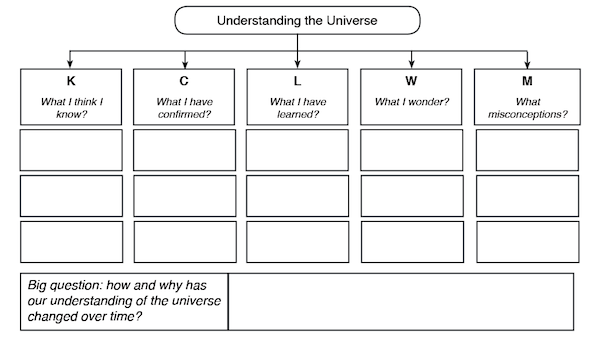Universe Mash-Ups Lesson Plan
Engagement: Introduction
During the engagement, students will be given an overview of the project assignment and will be introduced to key Cosmic Times concepts. The ultimate goals of the engagement activities are for students to understand the mash-up project requirements, chose a topic for their projects, and form a project group.
Handouts used in the Engagement
- Cosmic Times Keyword Match Pre-test: HTML, PDF, Word
- KCLWM Chart: HTML, PDF, Word
- Cosmic Times Post Test: HTML, PDF, Word
Classroom Instruction
-
Pre-test
If your students do not have previous experience with the Cosmic Times materials, have them take the Keyword Match Pre-test. The results will help guide the amount of introduction and review you will need to do to prepare your students to work on their video mash-ups. (Pre-test answers: 1-H, 2-J, 3-F, 4-G, 5-B, 6-I, 7-D, 8-A, 9-C, 10-E)
-
KCLWM graphic organizer
A KCLWM chart is a graphical organizer that can be used to drive instruction and guide student learning. In this lesson plan, the KCLWM chart is used to help students choose a topic for their Universe Mash-up project. Students fill out different columns of the KCLWM chart as the Engagement progresses.
K is for what they KNOW about our understanding of the Universe. This should be used initially as a pre-assessment, though students can continue to fill out new items in this column as the lesson progresses. C is for what a student has CONFIRMED about our understanding of the Universe. This will be filled out as the student watches/listens to the introductory presentation and as they proceed with their research. L is for what a student has LEARNED about our understanding of the Universe. This will be filled out as the student watches/listens to the introductory presentation and as they proceed with their research. W is for what a student WONDERS about our understanding of the Universe. Students fill this out at the end of the Engagement activities to help them come up with topics for their mash-up project. M is for MISCONCEPTIONS students had about our understanding of the Universe. Students fill this out throughout the lesson if they discover something they thought was a misconception. Hand out the KCLWM Chart to your students. Have them complete the "K", or "What I Know", column of the chart, indicating what they already know about cosmology. Have students pair-share their answers.

Sample KCLWM chart for Universe Mash-ups
-
Introductory presentation
Use the provided presentation to introduce Universe Mash-ups to your class and to guide them through a few of the basic ideas that have led us to our current understanding of the nature of the Universe.
Pause periodically to check for understanding by asking probing questions and to give students time to fill in the "C" and "L" columns of their KCLWM charts.
Video is available here:
A sample Universe Mash-up video, From the Inside Out, is also available to view. It is formally included in the Exploration (where you can find viewing and downloading options), but you may want to show it to students now, if they aren't clear about what they'll be doing.
-
Additional introductory activities as required
The following activities can be used if your students need further introduction to the Cosmic Times materials and topics. The goal is for your students to choose a question or topic to research for their mash-up.
- Jigsaw Activity – Students work in teams to learn about how scientists have come to know what they do about the Universe using articles from the Cosmic Times posters. Activity instructions can be found on the Cosmic Times website: http://go.nasa.gov/1cYCCqo
- Gallery Walk – Students work in small groups, visiting each Cosmic Times poster to answer an open-ended question about the information on that poster. Activity instructions can be found on the Cosmic Times website: http://go.nasa.gov/1cYCtmP
- Four Corners – Students split into four groups to discuss possible topics for their Universe Mash-up projects. (Activity instructions here.)
-
Assessment and Closure
Have students fill out the "W" column of their K-C-L-W-M chart to help them come up with big questions to research.
Optionally, have students take the Cosmic Times Post Test to assess if they have taken in the main ideas of the Cosmic Times posters. (Post-test answers: 1-D, 2-B, 3-D, 4-A, 5-C, 6-B, 7-D, 8-A, 9-B, 10-C)
At this time, students should choose a project group and research topic. The group size is largely up to the teacher, based on how well the students work in groups and the number of available computers. Ideally a group would be 2-3 students, since it can be difficult for larger groups to work together at a computer station. See "Additional Tips" below for topic suggestions for students who may be having trouble choosing.
Additional tips for the Engagement
- If you will be publishing the students' work, make sure to obtain signed permission release forms. This may be a difficult task, so think of creative ways to get students to turn them in early. For example, you can make it a requirement that students turn this in before working on their projects, or you may give extra points to those who turn in their slips early.
- Discover where your students' interests lie. Have students ask big questions and research those questions.
- Here are a few suggested topics for your students
- Biographical reports on scientists
- History of Nobel Prizes for astronomy work
- Exploration of various telescopes, observatories and satellites
- Stars
- Galaxies
- Big Bang
- Supernovae
- Measuring distances in astronomy
- Black holes
- Dark energy
- Dark matter
- Relativity
- Expanding Universe
← Background on Video Production | ↑ Universe Mash-up Lesson Home | Exploration →



